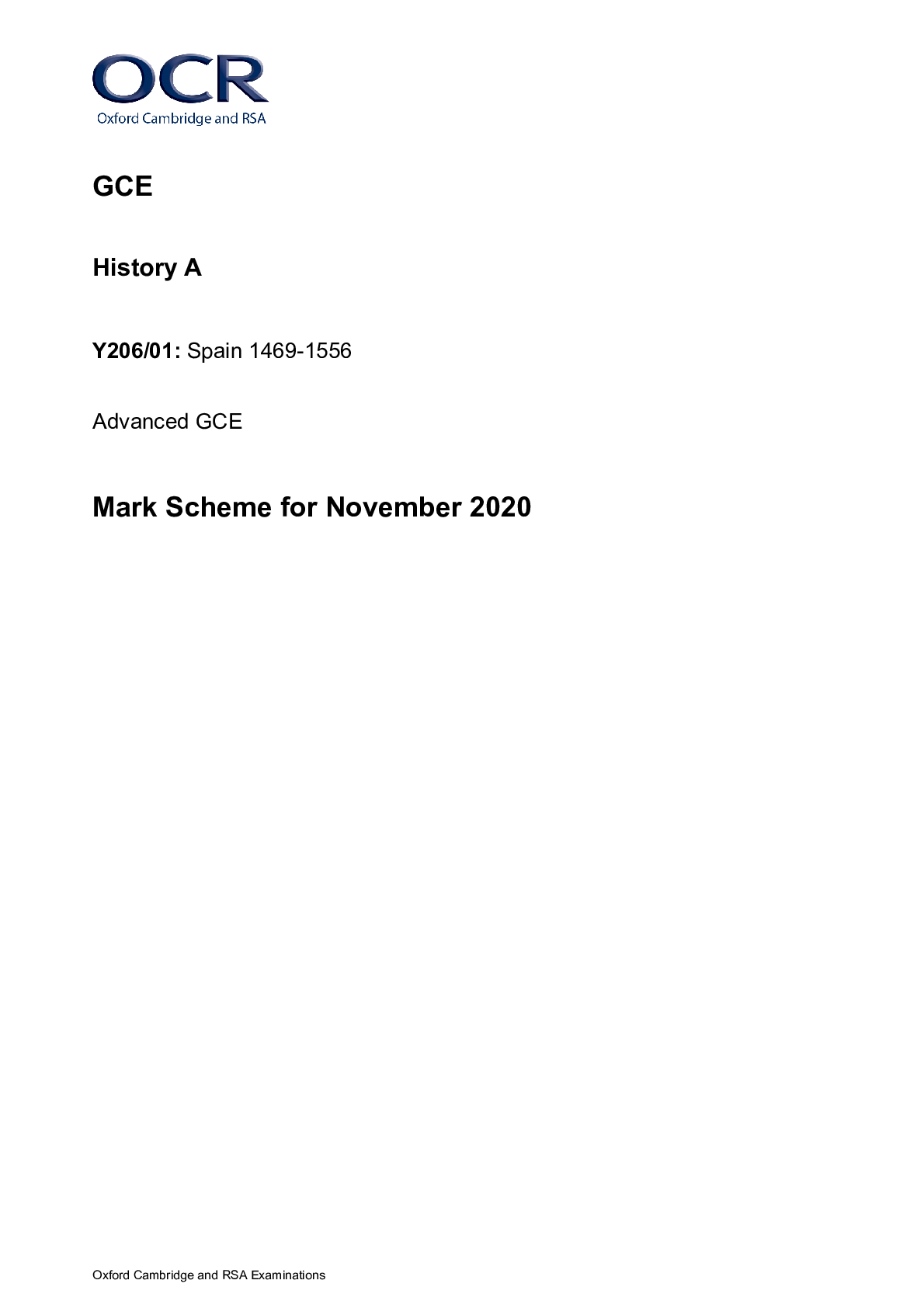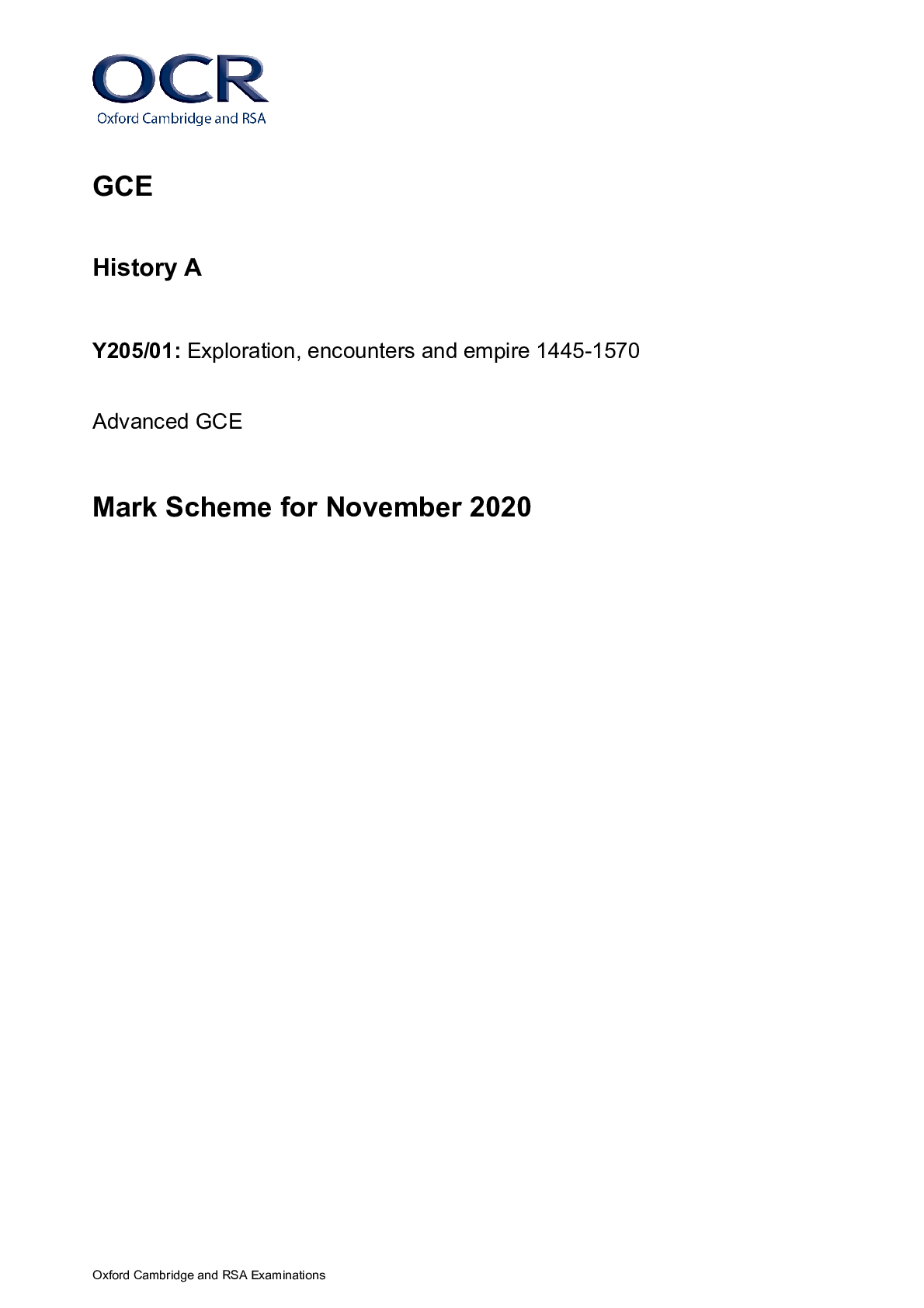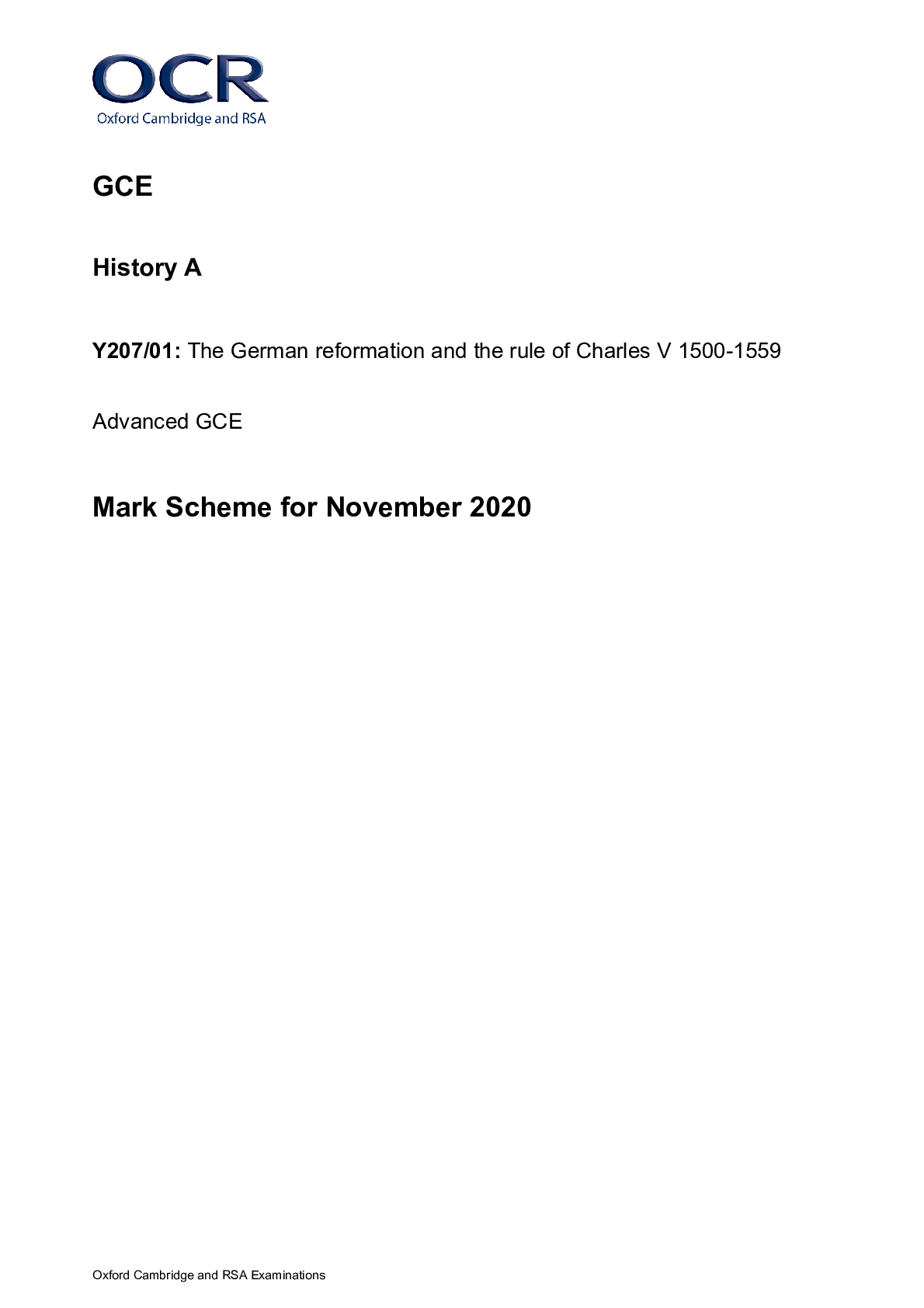Classical Civilisation > AS Mark Scheme > GCE Classical Civilisation H408/31: Greek religion Advanced GCE Mark Scheme for November 2020 (All)
GCE Classical Civilisation H408/31: Greek religion Advanced GCE Mark Scheme for November 2020
Document Content and Description Below
Oxford Cambridge and RSA Examinations GCE Classical Civilisation H408/31: Greek religion Advanced GCE Mark Scheme for November 2020Oxford Cambridge and RSA Examinations OCR (Oxford Cambridge and... RSA) is a leading UK awarding body, providing a wide range of qualifications to meet the needs of candidates of all ages and abilities. OCR qualifications include AS/A Levels, Diplomas, GCSEs, Cambridge Nationals, Cambridge Technicals, Functional Skills, Key Skills, Entry Level qualifications, NVQs and vocational qualifications in areas such as IT, business, languages, teaching/training, administration and secretarial skills. It is also responsible for developing new specifications to meet national requirements and the needs of students and teachers. OCR is a not-for-profit organisation; any surplus made is invested back into the establishment to help towards the development of qualifications and support, which keep pace with the changing needs of today’s society. This mark scheme is published as an aid to teachers and students, to indicate the requirements of the examination. It shows the basis on which marks were awarded by examiners. It does not indicate the details of the discussions which took place at an examiners’ meeting before marking commenced. All examiners are instructed that alternative correct answers and unexpected approaches in candidates’ scripts must be given marks that fairly reflect the relevant knowledge and skills demonstrated. Mark schemes should be read in conjunction with the published question papers and the report on the examination. © OCR 2020H408/31 Mark Scheme November 2020 2 Annotations Symbol Description Comment Tick worthy of credit ? Unclear S error of spelling E error of grammar, punctuation or expression F error of fact ^ Omission H Line to draw an attention to an error V Wavy Line to draw attention to something H Wavy Line to draw attention to something ……… Highlight as directed by PE IRRL irrelevant point REP conspicuous repetitionH408/31 Mark Scheme November 2020 3 L illegible word or phrase BP blank page – this annotation must be used on all blank pages within an answer booklet and on each page of an additional object where there is no candidate response. MARKING INFORMATION Introduction Your first task as an Examiner is to become thoroughly familiar with the material on which the examination depends. You should ensure that you have copies of these materials: ● the specification, especially the assessment objectives ● the question paper and its rubrics ● the mark scheme. You should ensure also that you are familiar with the administrative procedures related to the marking process. These are set out in the OCR booklet Instructions for Examiners. If you are examining for the first time, please read carefully Appendix 5 Introduction to Script Marking: Notes for New Examiners. Please ask for help or guidance whenever you need it. Your first point of contact is your Team Leader. Using the mark scheme Please study this mark scheme carefully. The mark scheme is an integral part of the process that begins with the setting of the question paper and ends with the awarding of grades. Question papers and mark schemes are developed in association with each other so that issues of differentiation and positive achievement can be addressed from the very start. This mark scheme is a working document; it is not exhaustive; it does not provide ‘correct’ answers. The mark scheme can only provide ‘best guesses’ about how the question will work out, and it is subject to revision after we have looked at a wide range of scripts. The Team Leader’ standardisation (SSU) meeting will ensure that the mark scheme covers the range of candidates’ responses to the questions, and that all Examiners understand and apply the mark scheme in the same way. The mark scheme will be discussed and amended at the meeting, and administrative procedures will be confirmed. Please read carefully all the scripts in your allocation and make every effort to look positively for achievement throughout the ability range. Always be prepared to use the full range of marks. Information and instructions for examiners The practice scripts provide you with examples of the standard of each level. The marks awarded for these scripts will have been agreed by the Team Leaders and will be discussed fully at SSU.H408/31 Mark Scheme November 2020 4 The specific task-related indicative content for each question will help you to understand how the level descriptors may be applied. However, this indicative content does not constitute the mark scheme: it is material that candidates might use, grouped according to each assessment objective tested by the question. It is hoped that candidates will respond to questions in a variety of ways. Rigid demands for ‘what must be a good answer’ would lead to a distorted assessment. Candidates’ answers must be relevant to the question. Beware of prepared answers that do not show the candidate’s thought and which have not been adapted to the thrust of the question. Beware also of answers where candidates attempt to reproduce interpretations and concepts that they have been taught but have only partially understood. ASSESSMENT OBJECTIVES Candidates are expected to demonstrate the following in the context of the content described for the individual component: AO1 Demonstrate knowledge and understanding of: ● literature, visual/material culture and classical thought ● how sources and ideas reflect, and influence, their cultural contexts ● possible interpretations of sources, perspectives and ideas by different audiences and individuals. AO2 Critically analyse, interpret and evaluate literature, visual/material culture, and classical thoughts, using evidence to make substantiated judgements and produce coherent and reasoned arguments. Individual questions are designed to allow the distribution of marks between the Assessment Objectives. For some points based marking and the levels of response questions you are required to identify a candidate’s performance under each assessment objective and award marks accordingly. Marking Scripts Answers must be marked using the level descriptors in the marking grids and a mark awarded for each Assessment Objective. The points in the mark scheme are indicative content only and offer some question specific guidance. Credit should be given for other points and different views, if they seem possible and are well argued or supported by good evidence. You must avoid negative marking - don’t deduct marks for individual errors. All marks should be allocated by reference to the assessment grid. Any queries on unexpected answers please consult your Team Leader/Principal Examiner. Using annotations ● Take great care to place a tick (see below) against any valid points that lead you to think at all favourably of the answer. ● Do not leave any page unmarked (as a last resort tick the very bottom of a page to indicate that you have read it - otherwise Team Leaders/Principal Examiners cannot tell whether account has been taken of that page). ● Underline errors and place the appropriate symbol in the margin. ● Indicate that you have looked at every page of the answer booklet by placing the BP symbol at the top and bottom of any blank pages.H408/31 Mark Scheme November 2020 5 Ticks: these are the simplest, quickest and most efficient means for examiners to convey approval to Senior Examiners, and they should be inserted where they can be most effective. If the point you wish to highlight is in the middle of a paragraph, then put the tick in the middle of a line in the middle of a paragraph. Overuse of the tick tends to devalue its effectiveness. Do use ticks to draw attention to anything worthy of credit [even single words]. Do not use ticks as a substitute for marking/assessment; marks for questions must be determined by reference to the assessment grid, NOT by mechanical addition of ticks. Highlighting: use highlighting as directed by your Principal Examiner. QUALITY OF EXTENDED RESPONSE ● Reasonable but not excessive account should be taken of particularly poor spelling (S), punctuation, and other defects in English grammar and expression (E). ● Legibility: use the sign (L) in the margin to areas of a script which you cannot read. ● Extreme cases of illegibility should be referred to your Team Leader/Principal Examiner.H408/31 Mark Scheme November 2020 6 Section A Question Indicative Content Marks Guidance 1(a) Who created the statue of Zeus located in the Temple of Zeus in Source A? ● Pheidias/Phidias (1). 1 (AO1) 1(b) Identify the buildings labelled A and B on the plan in Source A. ● A = Treasuries (1). ● B = Echo Stoa/Stoa Poikile/Painted Stoa (1). 2 (AO1) All legitimate answers should be credited. 2 Explain how the buildings, layout and features of Olympia enabled the Greeks to worship Zeus. You may use your knowledge of Source A in your answer. Examples might include: ● The significance of the Temple of Zeus within the sanctuary would have encouraged worship. (AO2) o Its central position in the sanctuary and large size in relation to other temples. (AO1) o Elaborate nature of architectural sculpture, east pediment depicts Zeus. (AO1) ● Other features connected to the Temple of Zeus were expressly designed for the worship of Zeus and showed a respect for the god. (AO2) o Sacrifices to Zeus would have taken place at the ash altar. (AO1) o Large scale of Pheidias’ statue, level of craftsmanship and use of gold and ivory to make statue. (AO1) ● Many buildings were connected with the Olympic games which were held in honour of Zeus. (AO2) o Stadium as a site for the athletic events. (AO1) o Use of Echo Stoa and other buildings as part of the administration of the Olympic games. (AO1) ● Other religious buildings in the sanctuary suggest a respect for Zeus. (AO2) o Treasuries as a place to house votive offerings. (AO1) 5 (AO1) 5 (AO2) Use the 10-mark marking grid. AO1 marks are awarded for the selection of material from the source. AO2 marks for the interpretation, analysis and evaluation of this outlined in the Levels of Response grid. The indicative content is a description of possible content. All legitimate answers and approaches must be credited appropriately.H408/31 Mark Scheme November 2020 7 3(a) Where in the Greek world was Xenophanes from? Answers may include: ● Colophon (1). ● Ionia (1). ● Asia Minor (1). 1 (AO1) All legitimate answers should be credited. 3(b) In what century did Xenophanes live? Answers may include: ● Born c.570 (1). ● Died c.475 (1). ● Accept 6th century (1) or 5th century (1). 1 (AO1) All legitimate answers should be credited. 4 Explain how traditional Xenophanes’ beliefs were about gods and goddesses. Examples might include: ● Xenophanes seems to have been critical of the traditional views of Homer and Hesiod. (AO2) o He denounced what Homer and Hesiod said about the gods, for instance that they were adulterous and deceitful. (AO1) ● His views on the anthropomorphic nature of the gods seems to be critical of traditional views. (AO2) o He questioned why the gods had the same physical appearance as the mortals who wrote about them. (AO1) o ‘One god…not at all like mortals in body or in thought’. (AO1) ● Some of his writings suggest a monotheistic or henotheistic view which was different to traditional polytheism. (AO2) o ‘One god is greatest among gods and men’. (AO1) ● Xenophanes’ theories on the natural world and natural phenomena did not rely on supernatural explanations which may have been traditional. (AO2) o He thought the sea (rather than the gods) was the source of water and wind. 5 (AO1) 5 (AO2) Use the 10-mark marking grid. AO1 marks are awarded for the selection of material from the source. AO2 marks for the interpretation, analysis and evaluation of this outlined in the Levels of Response grid. The indicative content is a description of possible content. All legitimate answers and approaches must be credited appropriately.H408/31 Mark Scheme November 2020 8 (AO1) o He describes Iris/ rainbows as a coloured cloud. (AO1) ● The difficulty in piecing together evidence of his and others’ writings make it harder to fully understand his beliefs in relation to traditional beliefs. (AO2) o His writings only survive in fragments. (AO1) o He was one of many pre-Socratic philosophers with views on natural philosophy and religion. (AO1) 5 ‘Homer and Hesiod had more influence on Greek religious beliefs than any Greek philosophers.’ Assess to what extent you think this is true. Justify your response. You may use your knowledge of Xenophanes as a starting point in your answer. AO1 Candidates might show knowledge and understanding of: ● The anthropomorphic nature of the gods as presented in Homer. ● Depictions of the gods in Greek art and how these compare to Homer’s portrayal of the gods. ● The prevalence of myths found in Homer which are depicted in Greek art. ● How sacrifice and the reciprocal relationship between gods and mortals is presented by Homer and Hesiod. ● Religious customs outlined by Hesiod. ● Dates of Homer/ Hesiod compared to philosophers. ● How education and location may have affected exposure to ideas. ● Range of religious beliefs suggested by different philosophers. ● Socrates’ trial. ● The religious views of Aristophanes or Thucydides and how these might link to philosophical questioning. AO2 Candidates may demonstrate evaluation and analysis through the use of some of the following arguments: ● The appearance and attributes of the gods that Homer describes can be seen in much Greek art suggesting this was a common view of the gods. ● Many individual scenes depicting the gods from the Iliad or Odyssey are shown in Greek art, again suggesting Homer’s influence on ideas about the gods’ behaviour. 10 (AO1) 10 (AO2) Assess using the marking grids for the 20-mark extended response. The indicative content is a description of possible content only; all legitimate answers and approaches must be credited appropriately. Whilst candidates may use the provided source as a starting point, they should not be penalised if they offer a full and detailed response which does not do so.H408/31 Mark Scheme November 2020 9 ● Stories are likely to have been more popular and accessible than philosophy, and the oral tradition helped to spread Homer’s work before it was written down. Even uneducated Greeks may have had exposure to these stories. ● Homer and Hesiod’s work dates from the 8th/ 7th century BC, earlier than many Greek philosophers which suggests their ideas became entrenched in Greek thought. ● We know more about Homer and Hesiod’s religious beliefs from their work that survives than we do of Xenophanes, and only know of Socrates’ beliefs from other sources. This suggests Homer and Hesiod’s work may have been more accessible and therefore influential. ● Hesiod’s descriptions of how to honour the gods seem to have been followed through observing correct rituals for sacrifice. ● Homer’s gods are shown with relatable human emotions and needs; this might have influenced common beliefs about the importance of sacrifice and offerings to the gods. ● Beliefs about the gods’ power as found in Homer are also found in tragedy, suggesting the influence of this idea. ● Much Greek philosophy was concentrated in Athens which may have limited exposure and influence to the ideas of philosophers. ● An exposure to philosophical beliefs about religion was likely only accessible for educated Greeks. ● Socrates’ trial may have brought more attention to his ideas although it is hard to say how influential these would have been. ● Other Greek writers can be seen to be questioning traditional views of the gods in a similar way to Xenophanes or Socrates, suggesting their ideas might have had influence. ● Socrates’ conviction sent the message that questioning traditional beliefs was to be discouraged, which may have affected how influential his ideas were at the time.H408/31 Mark Scheme November 2020 10 Section B Question Indicative Content Marks Guidance 6 ‘Greek religion never allowed the individual to experience the divine on a personal level.’ Evaluate how far you agree with this statement. AO1 Candidates might show knowledge and understanding of: ● The nature of the Olympian gods and how Greeks may have identified who to worship. ● The public nature of festivals such as the Panathenaia. ● Different levels of religious participation in the household, polis or in Panhellenic festivals. ● How Greeks participated in mystery cults. ● Worship of Asclepius to heal illnesses personal to oneself or one’s family. ● The personal nature of miracles. ● Beliefs about oracles and how they were used. ● The layout and function of Panhellenic sanctuaries such as Delphi and Olympia. ● The public nature of blood sacrifices. ● Acts of libation and votive offerings. AO2 Candidates may demonstrate evaluation and analysis through the use of some of the following arguments: ● Worship of the household gods may have allowed the Greeks to experience the divine on a personal level through worshipping gods that protected their home. ● Both libations and votive offerings could be made in the home with the participants choosing to offer something with personal significance to them. ● Libations and votive offerings could also be made on a larger scale at public festivals which suggests less of a personal religious act. ● Worship of a deity connected with a Greek person’s town, job or stage of life might have been a personal way of experiencing the divine because of personal significance to them. 10 (AO1) 20 (AO2) Assess using the marking grids for the 30-mark extended response. The indicative content is a description of possible content only; all legitimate answers and approaches must be credited appropriately. Learners are expected to make use of scholarly views, academic approaches and sources to support their argument; the approach to crediting this is outlined in the Levels of Response Grid.H408/31 Mark Scheme November 2020 11 ● Many shows of religious participation such as festivals and games were large public events where there may have been less chance to experience the divine on a personal level. ● The initiation of mystery cults suggests a choice of an individual to participate in something meaningful and personal to them. ● However, participation in mystery cults still happened in a group and the level of personal experience of the divine is unknown. ● The healing cult of Asclepius involved worship of the god to cure an illness or injury specific to an individual, suggesting a personal way of experiencing the divine. ● Miracles were believed to occur on a personal level, with a good causing a miraculous deed that affects an individual in a positive way. ● Individual pilgrimage to oracles suggests a way of experiencing the divine on a personal level to find out the answers to personal questions. 7 ‘Religion dominated every aspect of a Greek person’s life’. Evaluate how far you agree with this statement. AO1 Candidates might show knowledge and understanding of: ● Family life and the extent to which religion played a part in the household. ● Religion and rituals associated with important milestones in life e.g. birth, marriage, death. ● The role religion played within the deme and polis. ● The connection between religion and civic matters such as politics and law. ● Whether religion would have been significant for different jobs. ● The organisation of the city in relation to religious and non-religious buildings. ● The connection between public festivals and holidays with religion. ● The extent to which myths and cultural traditions were connected with religion. ● The gods’ spheres of influence and how these connected with different aspects of people’s lives. AO2 Candidates may demonstrate evaluation and analysis through the use of some of the following arguments: 10 (AO1) 20 (AO2) Assess using the marking grids for the 30-mark extended response. The indicative content is a description of possible content only; all legitimate answers and approaches must be credited appropriately. Learners are expected to make use of scholarly views, academic approaches and sources to support their argument; the approach to crediting this is outlined in the Levels of Response Grid.H408/31 Mark Scheme November 2020 12 ● Libations were poured to the gods to mark occasions such as the end of a day or a safe return from travels, which suggests many everyday occasions were connected with religion. ● Religious rituals would have been performed by priests at civic events in the polis, showing a connection between the two. ● The head of the household would have made offerings to household gods, suggesting that religion played a part in everyday family life. ● Women’s role in the family was not connected with religious duties and so religion may have played a less significant part in the everyday lives of women. ● The range of gods and their different spheres of influence might have encouraged religious participation from different groups of people; for instance, women getting married may have worshipped Hera. ● Most jobs were not obviously connected to religion. However, it is possible that people may have worshipped gods relevant to their work, for instance, Hephaestus for craftsmen or Demeter for farmers. ● Participation in religious festivals of the deme and polis was important for citizens, though some festivals may have been less important for non-citizens. ● Religion and politics were closely intertwined, and magistrates had some religious authority, suggesting that citizens would be exposed to religion through participation in public and civic life. ● Events such as the Panathenaia and Olympic Games were held on a large scale and provided another way to be involved in religion. ● The religious rituals associated with birth, marriage, death and burial shows how religion played an important role in key parts of a person’s life. ● Each polis would have religious buildings within it and often a boundary to demarcate the area, suggesting the relevance and visibility of religion to everyday life. ● Many myths and stories featured the gods, suggesting religion’s importance to Greek culture. ● It can be assumed that some aspects of life such as socialising or exercise did not have important connections to religion.H408/31 Mark Scheme November 2020 13 Guidance on applying the marking grids for the 10-mark stimulus question Two Assessment Objectives are being assessed in this question: AO1 and AO2. The two Assessment Objectives are equally weighted. Examiners must use a best fit approach to the marking grid. Where there are both strengths and weaknesses in a particular response, particularly imbalanced responses in terms of the assessment objectives, examiners should carefully consider which level is the best fit for the performance overall. For example, you should not be able to achieve a mark of 8 made up of AO1 = 6 and AO2 = 2. When using this grid: ● Determine the level: start at the highest level and work down until you reach the level that matches the answer ● Determine the mark within the level: consider whether the response consistently meets the criteria for the level, and/or could be described as closer to the level above or the one below. ● Marks for questions must be determined by reference to the assessment grid, NOT by mechanical addition of ticks. Level Marks Characteristics of Performance 5 9–10 AO1: Shows very good knowledge and understanding of the provided source/ideas through a range of well selected, accurate and precise material from it AO2: Fully and consistently engages with the question, with perceptive, critical analysis and interpretation of the provided source leading to convincing points which are well-supported and developed 4 7–8 AO1: Shows good knowledge and understanding of the provided source/ideas through a range of well selected, mostly accurate, material from it AO2: Engages clearly and directly with the question, with critical analysis and interpretation of the provided source leading to sound points, which are supported and developed 3 5–6 AO1: Shows reasonable knowledge and understanding of the provided source/ideas through use of a range of mostly accurate material from it AO2: Engages with some of the fundamental issues of the question, with analysis and interpretation of the provided source leading to some tenable points, which have some support and development 2 3–4 AO1: Shows basic knowledge and understanding of the provided source/ideas through use of some material from it with some degree of accuracy AO2: Engages with the general topic of the question, with little analysis and interpretation of the provided source leading to weak points, which have occasional support and development 1 1–2 AO1: Shows limited knowledge and understanding of the provided source/ideas through little use of accurate material from it AO2: Limited and very simplistic attempt to engage with the topic of the question, with very little analysis and interpretation of the provided source leading to points of little relevanceH408/31 Mark Scheme November 2020 14 0 0 No response or no response worthy of creditH408/31 Mark Scheme November 2020 15 Guidance on applying the marking grids for the 20-mark extended response Two Assessment Objectives are being assessed in this question: AO1 and AO2.The two Assessment Objectives are equally weighted. Examiners must use a best fit approach to the marking grid. Where there are both strengths and weaknesses in a particular response examiners should carefully consider which level is the best fit for the performance overall. Note that candidates can achieve different levels in each assessment objective, for example a Level 3 for AO1, and a Level 2 for AO2. When using this grid: ● Determine the level: start at the highest level and work down until you reach the level that matches the answer ● Determine the mark within the level: consider whether the response consistently meets the criteria for the level, and/or could be described as closer to the level above or the one below ● Marks for questions must be determined by reference to the assessment grid, NOT by mechanical addition of ticks. AO1 AO2 Level Marks Characteristics of Performance Level Marks Characteristics of Performance 5 9 – 10 ● very detailed knowledge and a thorough understanding of the material studied ● use of a range of well selected, accurate and precise material from classical sources and appropriate, effective use of their cultural context and possible interpretation 5 9 – 10 ● a very good response to the question containing a wide range of relevant points leading to convincing conclusions ● points are very well supported by perceptive critical analysis, interpretation and evaluation of classical sources and/or classical ideas The response is logically structured, with a well-developed, sustained and coherent line of reasoning 4 7 – 8 ● detailed knowledge and a sound understanding of the material studied ● use of a range of well selected, mostly accurate, material from classical sources and appropriate use of their cultural context and possible interpretation 4 7 – 8 ● a good response to the question containing a range of relevant points leading to appropriate conclusions ● points are consistently supported by critical analysis, interpretation and evaluation of classical sources and/or classical ideas the response is logically structured, with a well-developed and clear line of reasoning 3 5 – 6 ● reasonable knowledge and understanding of the material studied ● use of a range of mostly accurate material from classical sources and some use of their cultural context and possible interpretation 3 5 – 6 ● a reasonable response to the question containing some relevant points leading to tenable conclusions ● points are generally supported by analysis, interpretation and evaluation of classical sources and/or classical ideas the response presents a line of reasoning which is mostly relevant and has some structure 2 3 – 4 ● basic knowledge and understanding of the material studied 2 3 – 4 ● a basic response to the question containing some points, which may be narrow in scope and limited in relevancy, leading to weak conclusions ● points are occasionally supported by analysis, interpretation and evaluation of classical sources and/or classical ideas the response presents a line of reasoning but may lack structureH408/31 Mark Scheme November 2020 16 ● use of a limited range of material from classical sources with some degree of accuracy, and limited use of their cultural context and possible interpretation 1 1 – 2 ● limited knowledge and understanding of the material studied ● use of little accurate material from classical sources and little or no use of their cultural context and possible interpretation 1 1 – 2 ● little engagement with the question, any points or conclusions made are of little relevance ● isolated use of classical sources and/or classical ideas with little analysis, interpretation and evaluation the information is communicated in an unstructured way 0 0 ● no response or no response worthy of credit 0 0 ● no response or no response worthy of credit Guidance on applying the marking grids for the 30-mark extended response Two Assessment Objectives are being assessed in this question: AO1 and AO2.The two Assessment Objectives are equally weighted. Examiners must use a best fit approach to the marking grid. Where there are both strengths and weaknesses in a particular response examiners should carefully consider which level is the best fit for the performance overall. Note that candidates can achieve different levels in each assessment objective, for example a Level 3 for AO1, and a Level 2 for AO2. When using this grid: ● Determine the level: start at the highest level and work down until you reach the level that matches the answer ● Determine the mark within the level: consider whether the response consistently meets the criteria for the level, and/or could be described as closer to the level above or the one below ● Marks for questions must be determined by reference to the assessment grid, NOT by mechanical addition of ticks. AO1 AO2 Level Marks Characteristics of Performance Level Marks Characteristics of Performance 5 9 – 10 ● very detailed knowledge and a thorough understanding of the material studied ● use of a range of well selected, accurate and precise material from classical sources and appropriate, effective use of their cultural context and possible interpretation 5 17 – 20 ● a very good response to the question containing a wide range of relevant points leading to convincing conclusions ● points are very well supported by critical perceptive analysis, interpretation and evaluation of classical sources and/or classical ideas and secondary sources, scholars and/or academic works the response is logically structured, with a well-developed, sustained and coherent line of reasoning 4 7 – 8 ● detailed knowledge and a sound understanding of the material studied ● use of a range of well selected, mostly accurate, material from classical sources and appropriate use of their cultural context and possible interpretation 4 13 – 16 ● a good response to the question containing a range of relevant points leading to appropriate conclusions ● points are consistently supported by critical analysis, interpretation and evaluation of classical sources and/or classical ideas and secondary sources, scholars and/or academic works the response is logically structured, with a well-developed and clear line of reasoningH408/31 Mark Scheme November 2020 17 3 5 – 6 ● reasonable knowledge and understanding of the material studied ● use of a range of mostly accurate material from classical sources and some use of their cultural context and possible interpretation 3 9 – 12 ● a reasonable response to the question containing some relevant points leading to tenable conclusions ● points are generally supported by analysis, interpretation and evaluation of classical sources and/or classical ideas and there is some use of secondary sources scholars and/or academic works the response presents a line of reasoning which is mostly relevant and has some structure 2 3 – 4 ● basic knowledge and understanding of the material studied ● use of a limited range of material from classical sources with some degree of accuracy, and limited use of their cultural context and possible interpretation 2 5 – 8 ● a basic response to the question containing some points, which may be narrow in scope and limited in relevancy, leading to weak conclusions ● points are occasionally supported by analysis, interpretation and evaluation of classical sources and/or classical ideas and there is little or no use of secondary sources, scholars and/or academic works the response presents a line of reasoning but may lack structure 1 1 – 2 ● limited knowledge and understanding of the material studied ● use of little accurate material from classical sources and little or no use of their cultural context and possible interpretation 1 1 – 4 ● little engagement with the question and any points or conclusions made are of little or no relevance ● isolated use of classical sources and/or classical ideas with little analysis, interpretation and evaluation the information is communicated in an unstructured way 0 0 ● no response or no response worthy of credit 0 0 ● no response or no response worthy of creditOCR (Oxford Cambridge and RSA Examinations) The Triangle Building Shaftesbury Road Cambridge CB2 8EA [Show More]
Last updated: 1 year ago
Preview 1 out of 19 pages
Reviews( 0 )
Document information
Connected school, study & course
About the document
Uploaded On
Oct 10, 2022
Number of pages
19
Written in
Additional information
This document has been written for:
Uploaded
Oct 10, 2022
Downloads
0
Views
56

















.png)







